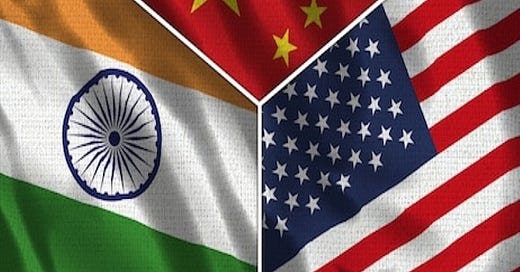India’s Becoming Impressively Autonomous Vis A Vis China & The US
The noticeable improvement of Chinese-Indian ties behind the scenes as evidenced by Delhi declining to endorse the US’ latest anti-BRI project and especially its use of yuan to purchase Russian coal are significant developments that deserve to be paid much more attention to than they’ve been thus far.
India’s pursuit of strategic autonomy has already been successfully practiced vis a vis Russia and the US as proven by that South Asian civilization-state’s refusal to capitulate to American pressure by condemning then sanctioning Moscow. It’s now in the process of being practiced vis a vis China and the US as well as evidenced by two recent developments that haven’t received the attention that they deserve.
The first is that India declined to endorse the US’ latest project for countering China’s Belt & Road Initiative (BRI) in spite of Delhi itself having publicly shared its apprehensions in the past about Beijing’s global network of connectivity projects. The second development was much more meaningful than just words that could always be walked back as circumstances change since it involves its purchase of Russian coal with yuan.
There’s a third development as well though it’s much more speculative in terms of its relevance to Chinese-Indian relations and that’s Pakistan’s lack of participation in last week’s BRICS+ conference that was held on the sidelines of that group’s virtual meeting hosted by the People’s Republic last week. Islamabad very strongly hinted that Delhi blocked it from taking part in that event, though Beijing as the host evidently went along with India’s reported objections for reasons that remain unclear.
About that last-mentioned and admittedly speculative development with respect to Chinese-Indian ties, there could have been a quid pro quo agreed to between these Great Powers in hindsight whereby Pakistan would be left out of the conference in exchange for Delhi declining to endorse the US’ latest anti-BRI project and continuing to go through with its purchase of Russian coal with yuan. If that was the case, then it could be connected to Beijing’s implied disapproval of Pakistan’s post-modern coup.
Leaving that curious incident aside since it can’t be known for sure exactly why China went along with India’s implied obstruction of Pakistan’s hoped-for participation in that conference, the first two developments in and of themselves already say a lot about India’s pursuit of strategic autonomy vis a vis China and the US in spite of its prior distrust of Beijing stemming from the summer 2020 clashes over the Galwan River Valley. Some analytical insight will now be shared about these observations.
First, the global systemic transition to multipolarity is passing through a bi-multipolar intermediary phase whereby International Relations are presently shaped most influentially by the American and Chinese superpowers. India, as a Great Power located on the second rung of this hierarchy above comparatively medium- and smaller-sized states, aspires to accelerate the emergence of tripolarity in Eurasia through strategic partnerships with Russia and Iran and in the Indo-Pacific with ASEAN.
All the while, it’s carefully balancing between the US-led Global Billion via its cooperation with the G7 and the Chinese-led Global South through its leading participation in BRICS in an attempt to gradually transition the international economic-financial system into a more equal, fair, and just one, though without inadvertently ceding too much influence to Beijing by drastically accelerating this process. That explains its pursuit of a free trade pact with the US while also using yuan to buy coal from Russia.
The trend to pay attention to is that India realizes that siding too much with the US against China on the economic-financial front would be counterproductive to its own grand strategic interests related to midwifing a tripolar world order through its dual-tripolarity policy of simultaneously assembling such in Eurasia with Russia and Iran and in the Indo-Pacific with ASEAN. In other words, it could tilt the balance too much against China in the US’ favor and thus undermine India’s own economic-financial goals.
For that reason, while India is very clearly building up its military potential against China for what its leadership regards as deterrence reasons, it’s also intriguingly enhancing its economic-financial cooperation with the People’s Republic which also counts as its top trade partner anywhere in the world right now. This might appear nonsensical on the surface to casual observers but astute analysts understand the strategic reasons behind this policy as was just explained.
For India, the most important thing is to gradually reform International Relations – and especially its economic-financial dimension – away from their declining US-centric model in the multipolar direction all while “managing” China’s rise. To this end, it’s pragmatically engaging with both superpowers in multiple ways, especially economically-financially, all the while pursuing its policy of dual-tripolarity in Eurasia and the Indo-Pacific.
This complex balancing act has thus far helped to retain a semblance of order and stability in the increasingly chaotic global systemic transition to multipolarity. The noticeable improvement of Chinese-Indian ties behind the scenes as evidenced by Delhi declining to endorse the US’ latest anti-BRI project and especially its use of yuan to purchase Russian coal are significant developments that deserve to be paid much more attention to than they’ve been thus far.




